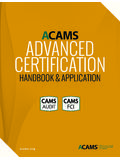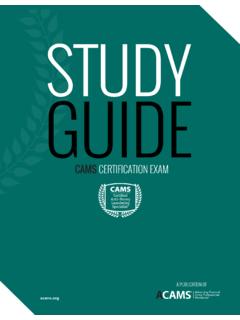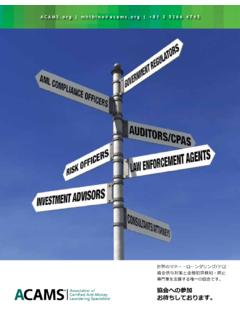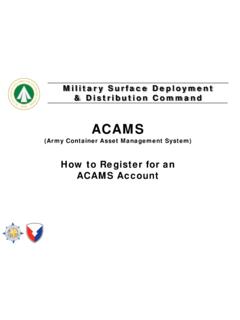Transcription of Generating a - Focus Technology Group
1 2 acams today | march/april 20072 acams today | march/april 2007 BackgroundAssessing customer risk and assigning risk scores to your customer portfolio are rapidly becoming requirements at most financial institutions. As a result, a key issue has become the practicality of im-plementing such procedures. Is there a practical and cost-effective way to gener-ate a risk score for each customer one that changes dynamically with changes in customer characteristics and transaction behavior?The Federal Financial Institutions Examination Council Bank Secrecy Act Anti-Money Laundering (BSA/AML) Ex-amination Manual, issued in June 2005, contains two separate indices that provide topical guidance on risk-rating customers: Appendix I: Risk Assessment Link to the BSA/AML Compliance Program Appendix K: customer Risk Versus Due Diligence and Suspicious Activ-ity MonitoringAn institution s AML specialist is a piv-otal player in originating, maintaining and strategically utilizing risk ratings for com-pliance and operational purposes.
2 Current challengesCurrent methods of implementing this requirement remain problematic for several reasons: New customers are interviewed with a series of questions and answers. A score is produced reflecting potential risks that customer poses, before any transactions have been performed. The sophistication of these processes and systems varies widely between institutions, but certainly integrat-ing risk assessments with customer origina-tion systems can be daunting. What happens to existing customers who were not interviewed during the origination process? A large majority of the customer base has no risk scores. Again, it s a daunting operational task to reach out to existing customers, one that is normally taken only if a cus-tomer shows significant risk.
3 What happens to this risk score after the customer completes the institu-tion s original customer Identifica-tion Program /Know Your customer CIP/KYC process? It may get stale, since the customer s situation may change with time. Perhaps the greatest challenge is seam-lessly integrating risk requirements into a customer acquisition process that is focused on selling products and services. An overly aggressive inaugural interview can be a sales de-terrent during the origination process at the branch (brick & mortar or Inter-net) goalMost institutions are in search of a magic bullet, a process that automatically generates customer risk scores daily, ac-curately and without significant impact on operations. This updated fluid risk score Generating a dynamic customer risk-ratingIt is vital that risk rating/scores be used operationally across all organiza-tional silos and in all risk mitigation acams today | march/april 2007march/april 2007 | acams today 2 becomes a risk mitigation/compliance asset by offering a valid snapshot of each and every holistic customer risk scoreIt is vital that risk rating/scores be used operationally across all organizational silos and in all risk mitigation functions.
4 A ho-listic cultural approach can be beneficial, resulting in both compliance and fraud de-tection enhancements. Simultaneously, the risk score provides a benchmark for service and business functions to use as they move forward on business plan holistic customer risk score contains two types of risk categories:Static risk attributes: These attributes describe the customer entity customer Identification Program, customer Due Dili-gence, Enhanced Due Diligence, Know Your customer (CIP/CDD/EDD/KYC) and do not change frequently. More important, they are contained in virtually every core pro-cessing system as part of normal customer information, and reflect current changes. By risk-rating specific values of these fields, this data can be valuable.
5 For example: Is the customer entity a business or a person? NAICS code: What type of business is this entity? ZIP code or Census Tract: geographic risk indicators Does the customer exist within a High-Intensity Drug Trafficking Areas (HIDTA) and High Intensity Money Laundering and Related Fi-nancial Crime Areas (HIFCA) zones? Distance risk: How far from the bank does the customer live/work? Is the customer a foreign national? What country does the customer re-side/work in? Country risk customer open date: How long has this entity been a customer at the institution? New customer risk What products does this customer use at the institution? Product risk Is the customer an employee? CIP score The CIP risk assigned at origination Is the customer on any lists?
6 Politically Exposed Person (PEP) Your own hot list Is the customer part of a Select Employ-ee Group (credit unions)? What is the customer s expected behav-ior for risky transaction categories? Can be gathered at origination Or generated for these categories based on past history for customers who are not risk attributes: These reflect patterns of actual risky transaction behav-ior. They change on a daily basis and vary according to the risk profile of the financial institution. Transaction-based alerts should be generated by transaction monitoring sys-tems. These systems should be a combina-tion of computer software and employee a customer Number of SARs filed in the past for a customer Number of manual SARs filed in the past for a customerDynamic risk ratingIf the static and transaction risk scores are calculated every day the resulting com-bined scores reflect a valid dynamic risk value.
7 This dynamic customer risk rating accurately reflects the current condition of each customer . When used in combination with other AML analysis tasks and BSA compliance practices this dynamic risk score becomes a valuable asset for the AML specialist or BSA risk scores can be used to: Risk-value alerts and the order in which they are investigated Segment the customer database to se-lect and analyze the high-risk custom-er s transaction activity Review and log comments on the highest risk customers: Enhanced Due Diligence Support cross functional risk abate-ment efforts Review and update KYC and CIP efforts and data Provide a foundation for decision-mak-ing on a case-by-case basis for investi-gative and compliance efforts Provide support and analysis data for the institution s business practices ConclusionThere is tremendous value in a financial institution s current data, and when lever-aged that data can be a key factor in auto-mating the risk assignment process prac-tically and cost-effectively.
8 Once a financial institution or organization establishes such a process, the challenges of BSA compli-ance, money laundering detection and fraud mitigation become more manageable. Richard Jefferson, COO of Focus Technology Group , Goldfinger, CAMS, vice president of Focus Technology Group , @ Focus Technology An institution s AML specialist is a pivotal player in originating, maintaining and strategically utilizing risk ratings for com-pliance and opera-tional purposes. areview. The following are examples of condi-tions that may be monitored and risk-rated: Cash structuring alerts Terrorist financing pattern alerts Large wire monitor from high- risk countries Actual behavior exceeds expected be-havior for risky transaction categories Risk-rating of alert based on sub- ject sensitivity.
9 For example, an alert that has not been investigated would be of higher risk than one that was investigated and cleared, but lower than an alert being considered for a Suspicious Activity Report (SAR). Number and severity of past alerts for








